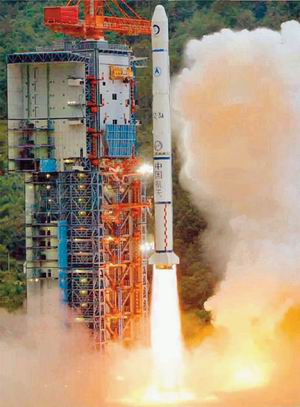
The circumlunar satellite Chang'e-1 blasts off on a Long
March 3A carrier rocket at 6:05pm yesterday from the No. 3 tower at the Xichang
Satellite Launch Center in southwestern Sichuan Province. Chinese scientists
have hailed the initial stage as a success. Inset: The orbiter. -
Xinhua
Shanghai Daily news
A country transfixed by television images yesterday held its collective
breath as the final countdown from ground control sounded "... three, two, one
... ignite!"
The rocket blasted off without a hitch; those bated breaths
turned to resounding cheers.
And so began China's ambitious 10-year
space-exploration plan as its first lunar probe speared into cloudy skies with a
mighty roar.
The Long March 3A rocket carrying the probe left at 6:05pm
from the Xichang Satellite Launch Center in the southwestern province of
Sichuan.
Thirty-seven minutes later, the Chang'e 1 satellite - named
after a legendary Chinese goddess who flew to the moon - separated from the
carrier rocket on a trajectory to reach lunar orbit in 13 days.
The
center declared the launch a success at 7:10pm.
Vice Premier Zeng Peiyan
arrived at the site and sent congratulations from President Hu Jintao for the
spectacular launch, the first step of China's three-stage lunar mission that is
targeted to end with a moon landing.
"The launch was very successful, and
everything is proceeding just as planned," said Wu Ji, director of the Space
Science and Applied Research Center under the Chinese Academy of
Sciences.
The rocket and satellite had a combined weight of more than 250
tons.
The million-kilometer-long first phase of the satellite's journey
is expected to take 13 days and 18 hours.
At 6:07pm, the 52.52-meter tall
rocket disconnected its first booster, which landed in the mountain areas of
neighboring Guizhou Province.
Two minutes later, the two-billion-yuan
(US$266.31 million) rocket cast its payload fairings, a device that covers the
satellite and protects it from shudders and heat during the powerful
lift-off.
The payload fairings should be found somewhere along the
boundaries between Guangdong and Jiangxi provinces.
At 6:10pm, the rocket, which has completed 14 successful launches in a row,
detached its second stage, which is expected to fall into the open sea southeast
of Taiwan.
The satellite disconnected from its carrier at
6:30pm.
The machine is expected to experience a total of 10 orbit
transfers during the journey, making it the most complicated satellite China has
produced. The journey includes a five-day orbit of Earth before a 116-hour
flight to transfer to a lunar orbit, which is scheduled to begin some time next
Wednesday.
The satellite is expected to relay the first picture of the
moon in late November and will also carry out a series of projects that includes
acquiring three-dimensional images and analyzing the distribution of elements on
the moon's surface during a year-long lunar exploration, the China National
Space Administration said.
The landmark satellite launch marks the first
step of China's three-stage moon mission, which will lead to a moon landing and
launch of a moon rover around 2012. In the third phase, another rover will land
on the moon and return to Earth with lunar soil and stone samples for scientific
research in about 2017.
China carried out its maiden manned space flight
in October 2003, making it only the third country in the world after the former
Soviet Union and the United States to have sent men into
space.



